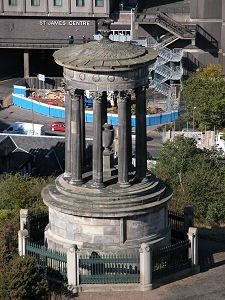 Edinburgh, Looking Towards Calton Hill |
Dugald Stewart lived from 22 November 1753 to 11 June 1828. He was a mathematician and a philosopher. The wider picture in Scotland at the time is set out in our Historical Timeline.
Dugald Stewart was born in Edinburgh. He was the son of Matthew Stewart, who was professor of mathematics in the University of Edinburgh. Dugald was educated at the Royal High School in Edinburgh before going on to study mathematics and moral philosophy under Adam Ferguson at the University of Edinburgh. He then studied under Thomas Reid at the University of Glasgow. In 1772, at the age of 19, he returned to Edinburgh to teach mathematics classes in the University of Edinburgh as his father's substitute due to illness. In 1775 they became joint Professors of Mathematics. From 1778 he also substituted for Adam Ferguson, teaching his moral philosophy course.
In 1785 Stewart succeeded Adam Ferguson as Professor of Moral Philosophy at the University of Edinburgh, a post he was to fill for the next quarter of a century, drawing in eminent pupils from across Britain and beyond. Stewart's course on moral philosophy covered ethics, political philosophy, and from 1800, political economy. Stewart spent the summer vacations of 1788 and 1789 in France, witnessing the early stages of the French Revolution first hand.
In 1783, Dugald Stewart married Helen Bannatyne. They had one son together before her death in 1787. In 1790 he was married a second time, to Helen D'Arcy Cranstoun, and they had a son and a daughter together. In 1809 the Stewart family moved into Kinneil House, Bo'ness, which had been placed at his disposal by the Duke of Hamilton.
Stewart was a prolific writer. His Outlines of Moral Philosophy, published in 1793, became a popular textbook and remained in print for many years. He also produced accounts of the lives and work of Adam Smith and Thomas Reid. In 1792 he published the first volume of Elements of the Philosophy of the Human Mind. The second volume was published in 1814, and the third in 1827. He died in Edinburgh in 1828 and a monument in his memory was subsequently erected on Calton Hill by the architect William Henry Playfair.

